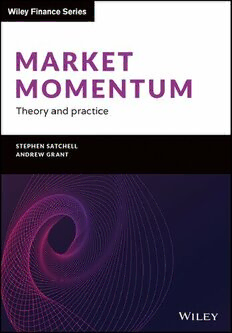
Market Momentum: Theory and Practice PDF
Preview Market Momentum: Theory and Practice
(cid:2) TrimSize:170mmx244mm Satchell19599326 ffirs01.tex V1-09/02/2020 11:11am Pagei Market Momentum (cid:2) (cid:2) (cid:2) (cid:2) TrimSize:170mmx244mm Satchell19599326 ffirs01.tex V1-09/02/2020 11:11am Pageii (cid:2) (cid:2) (cid:2) (cid:2) TrimSize:170mmx244mm Satchell19599326 ffirs01.tex V1-09/02/2020 11:11am Pageiii Market Momentum Theory and Practice By STEPHEN SATCHELL and (cid:2) ANDREW GRANT (cid:2) (cid:2) (cid:2) TrimSize:170mmx244mm Satchell19599326 ffirs01.tex V1-09/02/2020 11:11am Pageiv Thiseditionfirstpublished2021 ©2021StephenSatchellandAndrewGrant Registeredoffice JohnWiley&SonsLtd,TheAtrium,SouthernGate,Chichester,WestSussex,PO198SQ,UnitedKingdom Fordetailsofourglobaleditorialoffices,forcustomerservicesandforinformationabouthowtoapplyfor permissiontoreusethecopyrightmaterialinthisbookpleaseseeourwebsiteatwww.wiley.com. Allrightsreserved.Nopartofthispublicationmaybereproduced,storedinaretrievalsystem,or transmitted,inanyformorbyanymeans,electronic,mechanical,photocopying,recordingorotherwise, exceptaspermittedbytheUKCopyright,DesignsandPatentsAct1988,withoutthepriorpermissionof thepublisher. Wileypublishesinavarietyofprintandelectronicformatsandbyprint-on-demand.Somematerial includedwithstandardprintversionsofthisbookmaynotbeincludedine-booksorinprint-on-demand.If thisbookreferstomediasuchasaCDorDVDthatisnotincludedintheversionyoupurchased,youmay downloadthismaterialathttp://booksupport.wiley.com.FormoreinformationaboutWileyproducts,visit www.wiley.com. Designationsusedbycompaniestodistinguishtheirproductsareoftenclaimedastrademarks.Allbrand namesandproductnamesusedinthisbookaretradenames,servicemarks,trademarksorregistered trademarksoftheirrespectiveowners.Thepublisherisnotassociatedwithanyproductorvendor mentionedinthisbook. LimitofLiability/DisclaimerofWarranty:Whilethepublisherandauthorhaveusedtheirbesteffortsin preparingthisbook,theymakenorepresentationsorwarrantieswithrespecttotheaccuracyor completenessofthecontentsofthisbookandspecificallydisclaimanyimpliedwarrantiesof (cid:2) (cid:2) merchantabilityorfitnessforaparticularpurpose.Itissoldontheunderstandingthatthepublisherisnot engagedinrenderingprofessionalservicesandneitherthepublishernortheauthorshallbeliablefor damagesarisingherefrom.Ifprofessionaladviceorotherexpertassistanceisrequired,theservicesofa competentprofessionalshouldbesought. LibraryofCongressCataloging-in-PublicationData Names:Grant,AndrewRobert,1982-author.|Satchell,StephenEllwood, 1949-author. Title:Marketmomentum:theoryandpractice/AndrewRobertGrant,Stephen EllwoodSatchell. Description:FirstEdition.|Hoboken:Wiley,2020.|Series:Thewiley financeseries|Includesindex. Identifiers:LCCN2020020406(print)|LCCN2020020407(ebook)|ISBN 9781119599326(hardback)|ISBN9781119599470(adobepdf)|ISBN 9781119599371(epub) Subjects:LCSH:Investmentanalysis.|Securities—Prices.| Economics—Psychologicalaspects. Classification:LCCHG4529.G732020(print)|LCCHG4529(ebook)|DDC 332.63/2042—dc23 LCrecordavailableathttps://lccn.loc.gov/2020020406 LCebookrecordavailableathttps://lccn.loc.gov/2020020407 CoverDesign:Wiley CoverImage:©palamatic/shutterstock Setin10/12pt,SabonLTStdbySPiGlobal,Chennai,India. PrintedinGreatBritainbyCPIAntonyRowe 10987654321 (cid:2) (cid:2) TrimSize:170mmx244mm Satchell19599326 ffirs01.tex V1-09/02/2020 11:11am Pagev Abstracts 1AndrewGrant This chapter examines the behavioural finance argument for the existence of momentum profits. From a behavioural finance perspective, asset prices may deviate from fundamental values, which can persist if market frictions prevent a prompt correctiontomispricing.Asrisk,intheformofaFama-Frenchthree-factormodel,has been shown to provide a poor explanation for momentum returns, academics have sought psychology-inspired reasons for the phenomenon. We review the literature on behavioural finance and momentum, starting with the theoretical studies of the late 1990s, which have become highly influential. Following on from this, we discuss the recent empirical evidence supporting predictions such as slow information diffusion, incorrect updating of beliefs, trading at the 52-week high, individual investor trading and market-wide sentiment. Among the key insights is that behavioural finance can helpprovideanexplanationforstatisticalpatternsthatgeneratemomentumportfolios (cid:2) (cid:2) (as in Chapter 2) and may help practitioners in identifying themes for enhancing their investmentportfolios. 2SteveSatchell Inthischapterwelookatdifferentmomentumstrategiesandtheirproperties.Many of the empirical results of momentum strategies can be seen to result from the struc- tureofreturnprocessesandthedesignofthestrategy.Inparticular,consideringsimple cases,weinvestigatethereturndistributionsofwhatarethemajormomentumstrategies which are cross-sectional momentum (CSM), time-series momentum (TSM), relative strengthstrategies(RSS)andcross-assetmomentum.Forthecaseoftwoassets,wecan sayagreatdealaboutthestructureandpropertiesofreturns.Fromastatisticalperspec- tive,behaviouralanalysiswilldeterminethemagnitudeofmodelparametersalongwith, insomecases,thespecificationofthemodelitself.Takingtheseasgiven,thestatistical analysis will determine the properties of the strategy returns. In this form of analysis, weareinterestedinthepopulationmomentssuchasthemean,variance,skewnessand kurtosis but also the time-series moments of the momentum process. It is hoped that therelativelysimpleanalysisinthischapterwillhelpthereaderinlaterchapters. 3NickBaltasandRobertKosowski Motivated by studies of the impact of frictions on asset prices, we examine the effect of key components of time-series momentum strategies on turnover and perfor- mance.Weshowthatmoreefficientvolatilityestimationandprice-trenddetectioncan v (cid:2) (cid:2) TrimSize:170mmx244mm Satchell19599326 ffirs01.tex V1-09/02/2020 11:11am Pagevi vi ABSTRACTS significantlyreduceportfolioturnoverbymorethanone-third,withoutcausingastatis- ticallysignificantperformancedegradation.Weproposeanovelimplementationofthe strategythatincorporatesthepairwisesignedcorrelationsbymeansofadynamiclever- agemechanism.Thecorrelation-adjustedvariantoutperformsthenaïveimplementation of the strategy and the outperformance is more pronounced in the post-2008 period. Finally,usingatransactioncostsmodelforfutures-basedstrategiesthatseparatescosts into roll-over and rebalancing costs, we show that our findings remain robust to the inclusionoftransactioncosts 4JoseMencheroandLeiJi Inthischapter,westudytheriskandreturnofmomentumindevelopedequitymar- kets.Weconstructfactorportfoliosbycross-sectionalregression.Univariateregression resultsin‘simple’factorportfoliosthatcontain‘incidental’betsonotherfactors.Multi- variateregressionresultsin‘pure’factorportfoliosthatareneutraltoallfactorsexcept momentum. We compare performance of simple and pure momentum factors across variousdevelopedmarkets.Wefindthatsimpleandpurefactorshavevirtuallyidentical long-termperformancewithineachequitymarket.Thepurefactors,however,achieve this performance with considerably lower volatility, resulting in higher risk-adjusted performance.Wealsostudythevolatilitiesandcorrelationsofmomentumfactorsacross time.WefindthatthesequantitiespeakedduringtheInternetBubbleandtheFinancial Crisis.Finally,weshowthatformostperiods,momentumhasbeennegativelycorrelated (cid:2) (cid:2) withthemarket,thusofferingattractivediversificationopportunities. 5DandiBartolomeoandBillZieff Pricemomentumexposureisafamiliarconcepttoanyonewhohasstudiedequity return factors. Less addressed in the literature is how momentum effects in one asset classmanifestinotherassetclasses.Theoriesofcorporatefinancethatlinkequityand bond returns through their common dependence on the value of the firm have been known for some time, but these theories do not address the dynamics between debt and equity in a time-series context. Cross-Asset momentum provides a parsimonious description of such dynamics. We describe theoretical underpinnings and empirical resultsforseveralcross-assetclassmomentumeffects.Includedisadiscussionofequity momentumimpactintofixedincome,selectedmomentumeffectsinilliquidassets,such as real estate and private equity, and momentum results pertaining to commodities. Implications for active management in asset allocation and active management within assetclassesareexploredandhighlighted. 6KatharinaSchwaigerandMuhammadMassood Momentum as an investment strategy is a well-known component of systematic strategies. With the rise of exchange-traded funds (ETFs) and smart beta, momentum strategies are available to a broad range of clients including retail via a fully transpar- ent rules-based index strategy. The indices are built to weight and select stocks from an equity universe with high momentum exposure or high past returns. Those ETFs aim to offer momentum factor exposure at a competitive fee. In this chapter we shed (cid:2) (cid:2) TrimSize:170mmx244mm Satchell19599326 ffirs01.tex V1-09/02/2020 11:11am Pagevii Abstracts vii lightonthemomentumETFlandscapeanddiscusshowmuchmomentumisinmomen- tum ETFs. We find that momentum indices exhibit momentum characteristics despite differencesintheunderlyingindexmethodologies,lackofleverageandinfrequentrebal- ancing. 7OliverWilliams Thischapterreviewstime-seriesmomentum(TSM)strategiesascommonlyusedby CommodityTradingAdvisers(CTAs).WecompareTSMwithcross-sectionalmomen- tum(CSM)anddescribeexamplesofvariousmethodsusedforTSMsignalgeneration, showing that there are certain essential similarities in TSM approaches although the degreeoftechnicalcomplexityvariesconsiderablyacrossmethods.Wenotevariousstyl- izedfactsofCTAinvesting(e.g.relativelylowSharperatioandpositiveskewness)and highlight practically relevant results from existing literature concerning characteristics ofTSMreturns.Throughoutthechapterweusesimplemarketmodelstoillustrateour pointsandwederiveanexpressionforthecorrelationbetweenTSMandCSMreturns inthissetting,whichmaybeusefulwhencontemplatingassetallocationbetweenthese strategies. 8AndersPettersonandOliverWilliams Inthischapterweapplymomentumreturnsmodelsinanon-traditionalsetting:the (cid:2) valuationofcontemporaryart.Specifically,weconsiderwhetheramomentummodelis (cid:2) usefulatpredictingauctionoutcomesbasedonchangesinsubjectivevaluationopinions observedoverashortperiodpriortotheauction.Weuseanoveldataset(suppliedby ArtForecaster.com)thatcontainsmultiplevaluationsofthesamepieceofartprovided byindividualforecastersatapproximatelythesametime.Combinedwithauctioneers’ estimatesandhammerpricesthisdatacanbeusedtoestimateasimpledynamicmodel of valuation changes. We fail to find significant evidence of time-series momentum in thesevaluationchanges,butaforecastingstrategybasedoncross-sectionalmomentum appears to be effective. This implies that subjective opinion is more informative when considered on a relative basis (one work of art versus another) rather than outright, and we conjecture this may be due to a sub-conscious bias on the part of art market participantstowardspositiveratherthannegativesentiment.Weconcludethatmomen- tummodelscanprovideausefulframeworkforanalysisofinformationandbehaviour outsidetraditionalfinancialmarkets. 9YangGao Thischapterexplorestheinteractionbetweenmomentumandvolatility.Theliter- aturehasshownthatmomentumstrategiesusingvolatilityastheconditioningvariable strongly outperform plain momentum strategies by reporting higher alphas, increased Sharperatiosandimprovedskewness.Thesevolatility-managedmomentumstrategies benefitfromtheuseofvolatility,whichhasthepotentialtobetterforecastfuturereturns. We empirically review the various volatility-managed momentum strategies that are proposedintheacademicliterature.Ourfindingsshowstrongoutperformanceofboth the time-series (TSVM) and cross-sectional volatility-managed momentum strategies (cid:2) (cid:2) TrimSize:170mmx244mm Satchell19599326 ffirs01.tex V1-09/02/2020 11:11am Pageviii viii ABSTRACTS (CSVM)intheUSA,EuropeandAustralia.Wedocumentinterestingevidencethatthe TSVM strategy seems to work in the Chinese and Japanese markets where traditional momentumorCSVMdoesnotworkwell.Wefurtherdiscusstheroleofleveragecon- straints,turnoverandshort-sellingconstraintsinthepracticaluseofvolatility-managed momentum strategies. Last, we examine how volatility manages momentum risk and suggestthatmomentumisnotonlyrelatedtoitsownvolatility. 10AndrewGrant,OhKangKwonandSteveSatchell Theselectionofassetsbasedontherankingsofoneormoreoftheirattributesover apriorperiodisastandardpracticeintheconstructionofportfoliosinbothacademic andpractitionerfinance.Momentumisafamiliarexampleofthisactivity.Althoughthe propertiesofreturnsfromtheseportfolioshavebeenthesubjectofconsiderableempir- ical research, there is only limited literature investigating their theoretical properties. In this chapter, we address this gap by deriving analytically the distributional proper- ties of these portfolio returns under the assumption that asset attributes and returns are jointly multivariate normal. We show that prior sorting of asset attributes induces non-normality in the portfolio returns and that the returns depend on the order and nature of sorting The analysis looks at two fundamental types of sorting, both com- monlyusedbypractitioners,andtheauthorsshowthatthemethodofsortinginfluences thepatternofreturnsundercommonlyencounteredcircumstances. (cid:2) (cid:2) 11StefanoCavaglia,VadimMorozandLouisScott The research presented in this chapter extends and corroborates the findings of ScottandCavaglia(2016)whofirstillustratedthepotentialbenefitsofafactorpremia overlaytoaninter-temporalwealthaccumulationstrategythatisfullyinvestedinequi- ties.Weexamineapanelof5localfactorpremia(inclusiveofmomentum)ineachof21 developedequitymarketsand5regions.Innearlyallinstanceswefindthatwealthaccu- mulationissignificantlyenhancedbyatimeinvariant,equalweightedallocationtothese premia.Theenhancementisdriveninpartbythemeanreturnofthepremiabutmore importantly by their generally positive payoff in adverse market environments. The qualityandmomentumfactorpremiaarethelargestcontributorstothisresult.Apply- ing conventional measures of risk aversion we quantify the importance of downside protection to supporting the attainment of investors’ goals; the utility-based evidence suggeststhatsomefactorpremiaarevaluedbyinvestorsevenwhentheirexpectedreturn iszero. 12ChristopherPolk,MoHaghbinandAlessiodeLongis Factorcyclicalitycanbeunderstoodinthecontextoffactorsensitivitytoaggregate cash-flow news. Factors exhibit different sensitivities to macroeconomic risk, and this heterogeneity can be exploited to motivate dynamic rotation strategies among estab- lishedfactors:size,value,quality,lowvolatilityandmomentum.Atimelyandrealistic identification of business cycle regimes, using leading economic indicators and global risk appetite, can be used to construct long-only factor rotation strategies with infor- mationratiosnearly70%higherthanstaticmultifactorstrategies.Therulesintroduced (cid:2)
